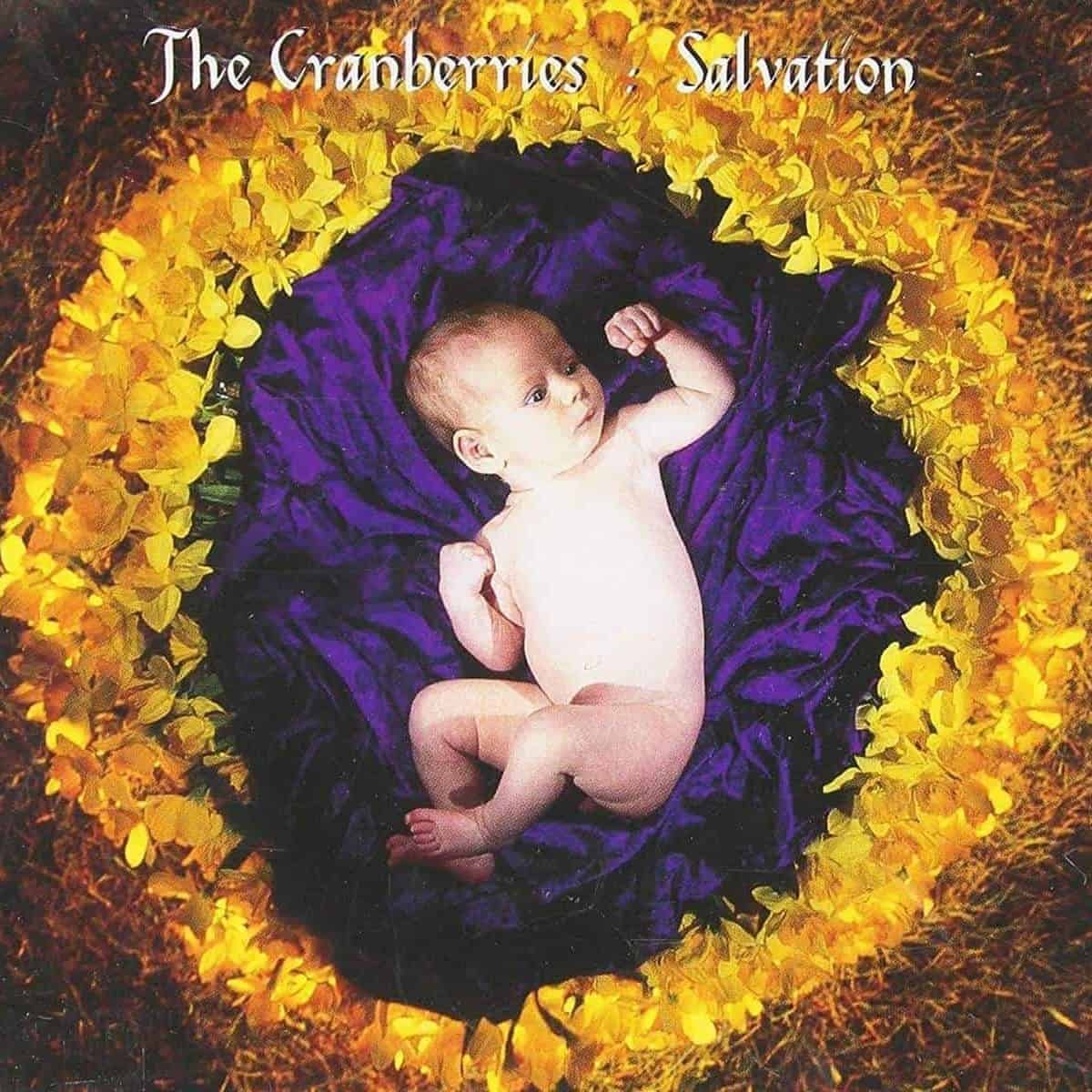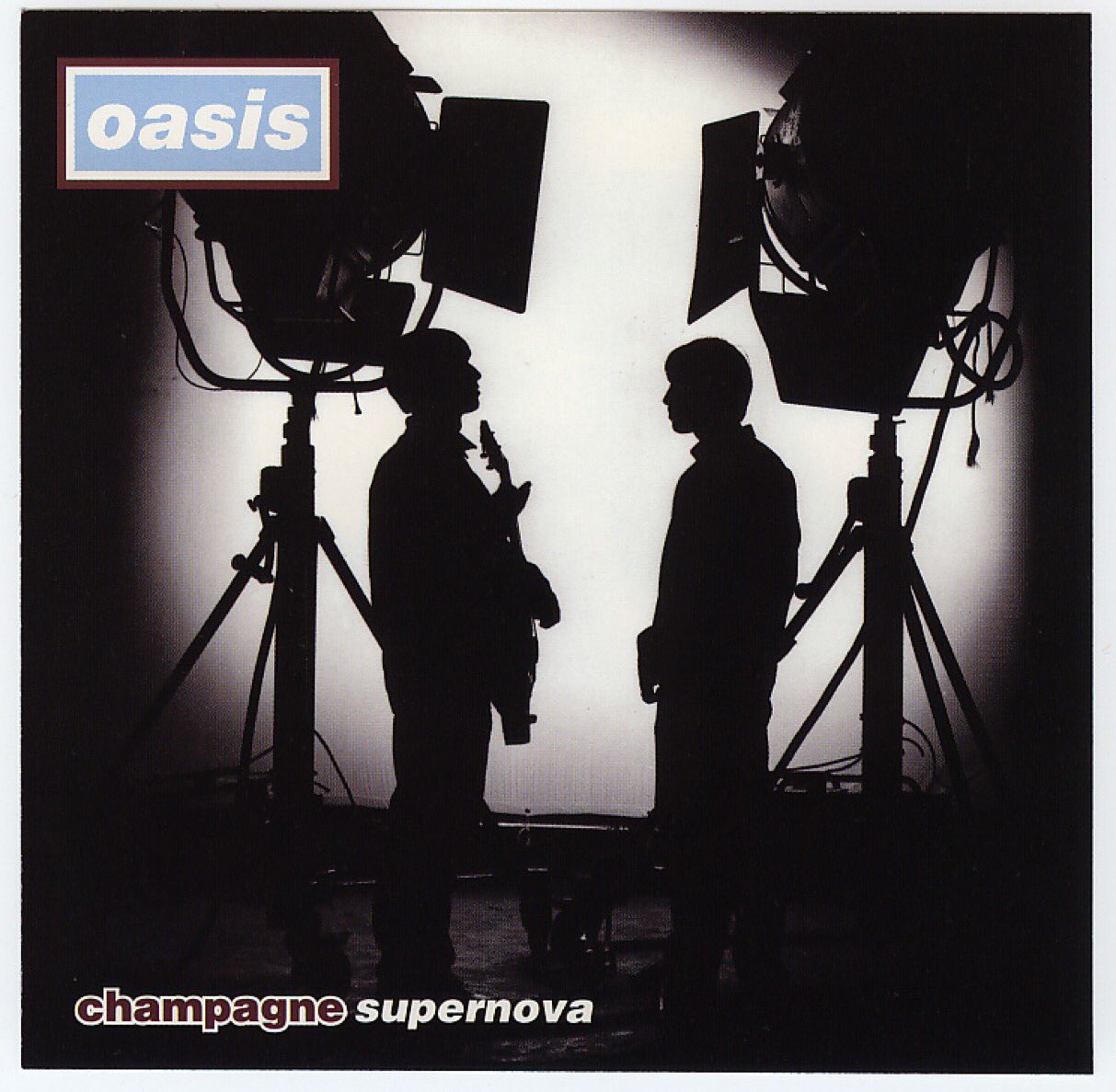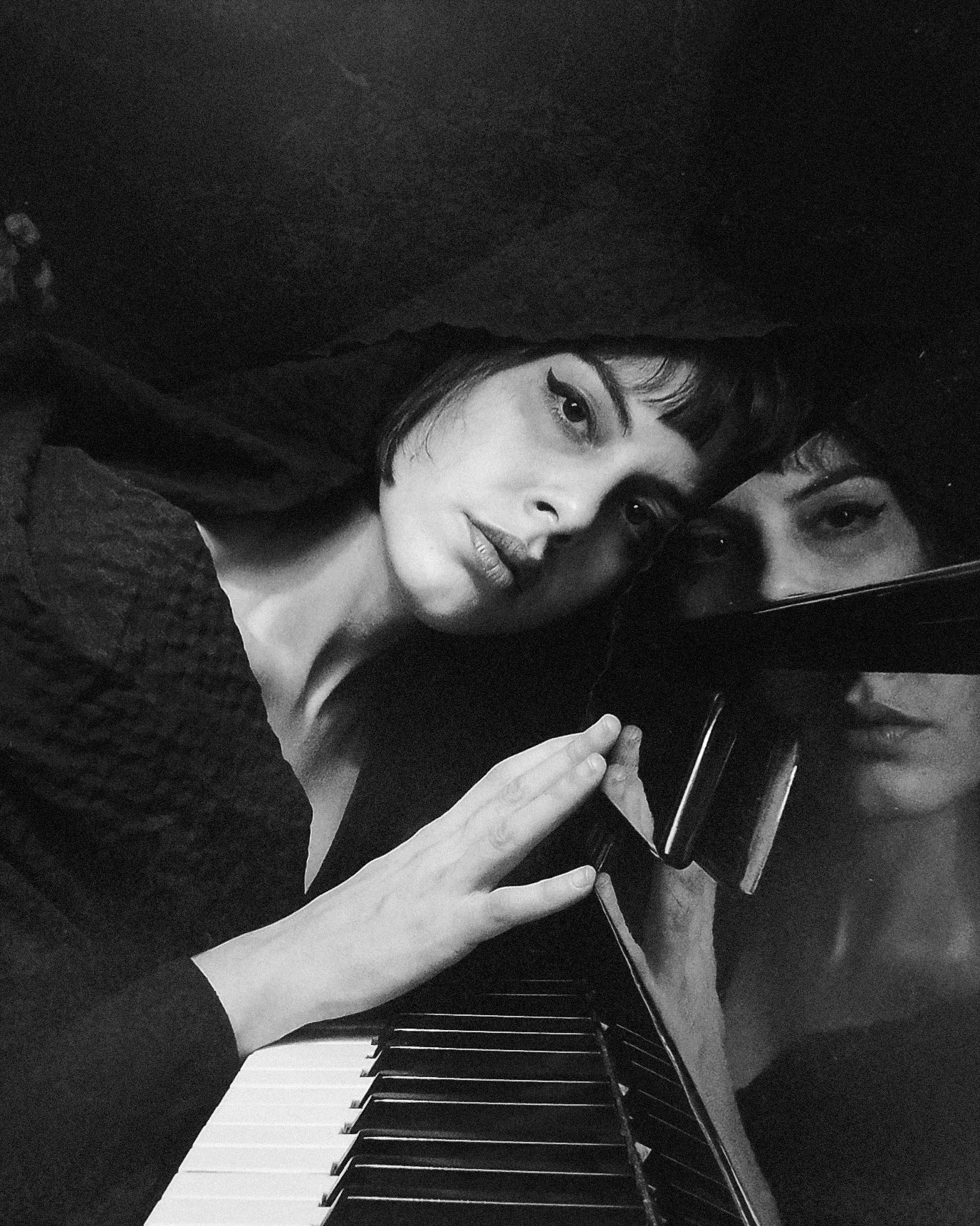I never thought of Lana Del Rey as a piano artist per se, but clearly, she is. Though she doesn’t play piano herself, the instrument features prominently in much of her music, and centrally on her newest release, which came out late last month. Did You Know That There’s A Tunnel Under Ocean Blvd is a stunning piano-based album with a weirdly long title (and a conspicuously absent question mark). Created in collaboration with producer Jack Antonoff, this expansive, dreamy album should finally put to rest any lingering notions that Lana Del Rey’s artistry is “inauthentic” (a common critique she faced early in her career). From top to bottom, the album folds inventive textures, harmonies, and musical twists into an enthralling amalgam of the sort rarely heard these days in mainstream pop music.Let’s dive into the album’s intoxicating second single, “A&W,” to examine how it works.
The arpeggiated piano and finger-picked guitar figure we hear at the start of “A&W” establishes the unusual harmonic language that makes the song so alluring. In a previous In Theory article, we discussed how Kurt Cobain used non-functional harmony to create bold and immensely evocative music -- an approach integral to Nirvana’s sound. We hear many of the same elements in Lana Del Rey’s “A&W.” Like Kurt Cobain, Lana uses chromatic mediant relationships to invoke a sound that can be alternately unnerving and beautiful -- or both at the same time.
Unpredictability
Before diving into Lana Del Rey’s use of chromatic mediants, let’s clarify some key concepts. Functional harmony is the idea that each chord in a piece of music serves a specific purpose.The chords all have pre-determined “roles,” as though they’re archetypical characters in a story. As the chords change, we experience predictable moments of tension and release in the music’s “narrative arc.” A particular chord in a musical phrase might feel unstable, as though it yearns to resolve (which it often does in functional harmony). The classic example is the V7-to-I “authentic cadence,” where the unstable V7 chord feels compelled to resolve “home” to the I chord. See Figure 1, below. An analogy might be the force an iron nail experiences as it’s pulled towards a nearby bar magnet. There’s a similar kind of harmonic “pull” that chords experience in functional harmony, creating expected cycles of tension and release. It’s one of the defining characteristics of most Western pop music — and like with the iron/magnet analogy, it possesses an air of predictability.

Non-functional harmony is any system that employs chords in a manner that doesn’t summon the same kind of tension-and-release moments we hear in functional harmony. With non-functional harmony, the chords don’t necessarily perform specific tasks. Instead, they exist to evoke a mood or atmosphere -- or just to impart color. Furthermore, non-functional harmonic chord progressions often move in unexpected ways. It brings to mind Impressionist music of the late 19th and early 20th centuries in Europe (think Debussy and Ravel), as well as 1960s modal jazz (a la Wayne Shorter, McCoy Tyner, et al.). Within non-functional (or multi-functional) harmonic systems, chromatic mediants can be potent devices because they travel in directions that we generally can’t predict -- so they perk up our ears. See Figure 2, below.
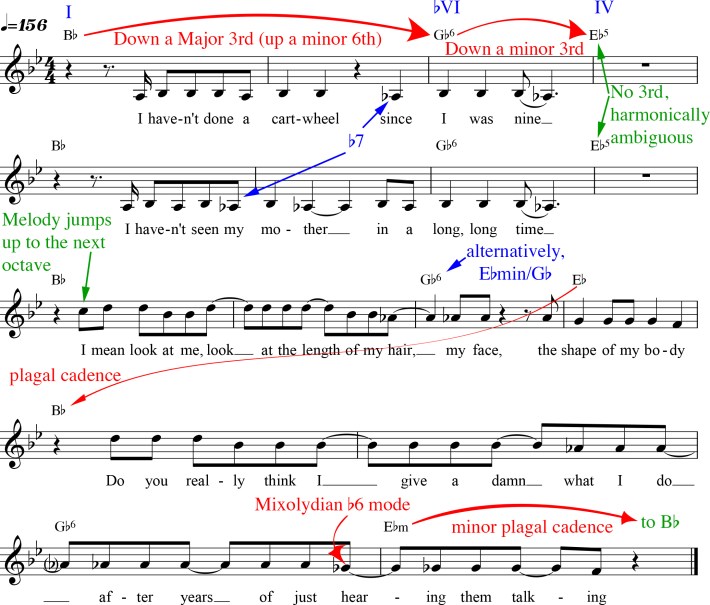
As we can observe in Figure 2, Lana Del Rey based the verses of “A&W” almost entirely on chromatic mediant/submediant relationships.The “mediant” is the 3rd scale degree, as it’s mid-way between the I (tonic) and V (dominant). The “submediant” is the 6th scale degree, as it’s mid-way between the IV (subdominant) and I (tonic) an octave above. We can think of mediants and submediants as reflections of each other: e.g., C is a mediant of A, and A is a submediant of C. The particular mediant/submediant flavor Lana uses is “chromatic” because it exists outside of the diatonic structure we normally expect to find in pop tunes.
The G♭6 chord doesn’t fit diatonically within the key of B♭ Major—meaning it’s foreign to that key center. It’s the ♭VI scale degree, which means it’s a Major 3rd down from the B♭ tonic (or a minor 6th up). We might expect a chord like this to sound random or disconnected — but it doesn’t. The movement from B♭ to G♭6 still feels grounded and coherent because both chords share a crucial common tone: the note B♭ is the root of the B♭ chord and it’s also the 3rd of the G♭6 (and the 5th of the E♭5 chord that follows). Lana repeatedly sings the B♭ note in her melody over these chords, which helps to glue the progression together. Further, because the “6” of the G♭6 chord is the note E♭, we hear smooth voice leading in the harmony as the note D (the third of the B♭ chord) acts like a leading tone that moves up a half step when we get to the G♭6 chord. It’s a lovely harmonic construction that imparts a feeling of longing or sadness.
You will hear chromatic mediants fairly often in film scores — with John Williams, Howard Shore, and Danny Elfman being perhaps the best-known frequent users. The specific cascading I-♭VI-IV chromatic mediant progression that Lana uses in “A&W” might sound familiar to you because variations of it form the basis of two iconic James Bond songs. Billie Eilish’s “No Time To Die” uses a i-VI-IV progression in the song’s turnaround. In Shirley Bassey’s “Goldfinger” (composed by John Barry), the main hook bounces between the I and ♭VI.
Returning to Kurt Cobain: can you spot his direct connection to Lana Del Rey? The verses of Nirvana’s “In Bloom” (and to some extent, “Heart Shaped Box”) employ the same chromatic mediant relationships as the verses of “A&W.”See Figure 3, below.

I’m reminded of Courtney Love’s recent remark that Kurt Cobain and Lana Del Rey are “the only two true musical geniuses [she’s] ever known.”
Minor Plagal Cadence And Harmonic Ambiguity
There’s another way to think of the G♭6 chord in the “A&W” verses: if we omit the 5th (the note D♭, which is superfluous), we can observe that it’s actually the first inversion of an E♭ minor triad -- i.e., it’s the minor iv chord relative to the B♭ tonic. In a previous In Theory article (on Mariah Carey’s “All I Want for Christmas is You”), we discussed how the “minor plagal cadence” (minor iv chord resolving to the I) invokes a nostalgic, bittersweet sound. So the particular flavors of chromatic mediants Lana uses here weave together the harmonic surprise of the I-♭VI-IV(iv) movement with the poignancy of the minor plagal cadence. (More on this shortly.) The result is a sound that’s both tender and haunting -- mirroring Lana’s lyrics reflecting on her childhood and her current struggles with societal pressure.
Notice that Lana’s melody uses the note A♮, but also prominently features the note A♭— the flatted-7th scale degree in the key of B♭ — demonstrating that the tune moves in and out of “Mixolydian” mode (a concept covered in a previous In Theory article on Lorde’s “Solar Power.”) See Figure 2, above. Mixolydian mode is the 5th mode of the major scale, and it possesses a rather ambiguous feel. It sounds a bit more exotic than the major (“Ionian”) scale because the lowered 7th scale degree imparts a kind of mystical quality. You can hear this sound in Northwestern European folk music of the Celtic tradition, as well as in Carnatic music of South India (Harikambhoji raag) and Hindustani music of North India (Khamaj raag). When Lana sings the line, “length of my hair, my face, the shape of my body,” the combination of the flat-7 note (A♭) and the natural-6 note (G♮) intensifies the Mixolydian sound established earlier in the verse.
When Lana sings the next line, we hear a dramatic development:the melody on the lyric “what I do after years of just hearing them talking” uses the flatted 7thnote (A♭) combined with the novel introduction of the flatted 6th (G♭). Though we’ve already heard G♭ in the harmony, this is the first time we’re hearing it in Lana’s vocal melody. (Remember:she sang a G♮ in the nearly identical previous line.) This suggests we’ve now moved into “Mixolydian flat 6” mode, sometimes called “Aeolian Dominant.” It’s the 5th mode of the melodic minor scale.In Indian music, it’s the raag called “Charukeshi,” and it possesses an even more striking sound than standard Mixolydian because it blends together the major and natural minor scales in equal parts. There’s a joke among musicians that describes Mixolydian flat 6 as the “mullet mode”: Major in the front, minor in the back.See Figure 4, below.

Check out this performance from the 2006 Darbar Festival featuring sarod and violin. It’s a marvelous example demonstrating the haunting sound of Mixolydian Flat 6:
Lana’s use of Mixolydian Flat 6 at the end the first verse facilitates the expressive minor plagal cadence that brings us to the song’s chorus section. This is because, in the key of B♭, the flatted 6th scale degree (G♭) forms the minor-3rd interval on the IV (E♭5) chord -- effectively turning it into an E♭min.
From Greece To The Afro-Caribbean Islands
Before diving into the chorus, let’s briefly explore what Jack Antonoff is doing in the verses of “A&W” with the piano and with what sounds like a baritone acoustic guitar. The rhythms are crucial here because they impart a kind of propulsive syncopation that helps the song avoid feeling maudlin. The 8th-note arpeggio pattern comes from a simple polyrhythm known as “hemiola.” We can trace that word to the Greek “hemiolios,” meaning “one and a half.” Accordingly, hemiola indicates a ratio of 3:2, which describes the kind of rhythmic subdivision we hear in the instrumental parts during the song’s verses.
The 8th notes within each bar subdivide into what feels like a “6-against-4” pattern (3:2 ratio), with the rhythmic phrases crossing over the bar lines between measures 1-2 and 3-4. For the math to come out evenly in true hemiola fashion, the song would need to group its 4/4 bars into multiples of three. But since the phrase lengths in “A&W” are based on multiples of two bars, the metric quotient leaves us with a remainder -- which requires inserting two extra quarter notes (four eighth notes) at the end, in order to complete each 2-bar cycle. See Figure 5 below.
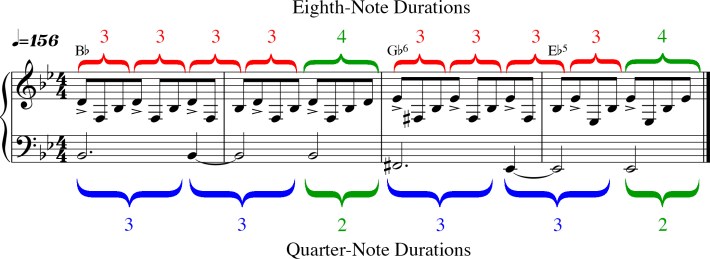
If this makes your head spin, don’t worry ... just know that the point of the asymmetrical rhythmic pattern here is to inject fluid motion into the verses using an oddly accented groove with a steady pulse. Without the shifting pattern of emphasis, the verses might run the risk of feeling somber or forlorn.
It’s interesting that this rhythmic figure is related to the popular pattern known as “tresillo,” which we hear quite a lot in Latin-American music. Tresillo (meaning “triplet” in Spanish) derives from an essential Sub-Saharan African rhythm that uses a contrasting duple-pulse “cross beat” cell. It eventually found its way to the Caribbean Islands via the horrific institution euphemistically called the Transatlantic slave trade -- ultimately yielding the Afro-Cuban clave pattern that emerged in the late 19th and early 20th Centuries. In essence, tresillo is a repeated figure that uses just the first bar in a traditional 3:2 clave pattern. Take the rhythm accents from only the first or third bars of the “A&W” verse, shown above in Figure 5, and repeat that pattern. There you have it: instant tresillo!
Here's a well-known recent example of the tresillo rhythm in action:
Authenticity
Refocusing our attention to the chorus of “A&W”: at the start of this section, we hear Lana’s double-tracked unison vocal for the first two bars, followed by a 2-part vocal harmony (with the melody comprising the top line). The multi-tracked layered vocal is a crucial component of the Lana Del Rey sound, and it produces a gentle lift when we hear it here. The eighth-note ostinatos from the verse now shift to a quarter-note pattern, and the sparseness of the rhythm section helps to make this part of the song feel important. It's a compelling combination that, paradoxically, feels both floaty and heavy. The chords descend chromatically from B♭ using chord inversions, and the vocal harmony moves diatonically over each respective chord in minor third intervals. See Figure 6, below.
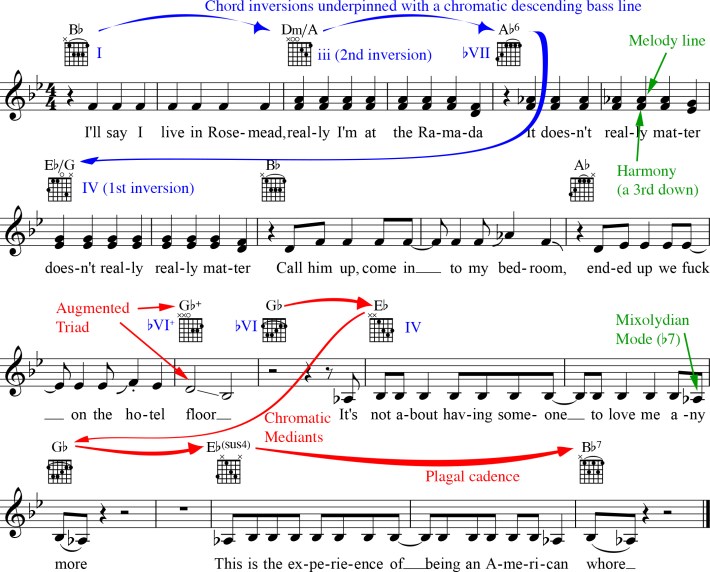
One of the hallmarks of Lana Del Rey’s songwriting is the impeccable way her music composition buttresses her lyrics. On the line, “ended up we fuck on the hotel floor,” the phrase concludes with Lana sliding down from a D to a B♭ (a Major third interval) in her melody, over a G♭ chord root. This combination yields a G♭ augmented triad -- i.e., a G♭ Major chord but with the 5th raised a half step. Augmented triads (denoted with a “+” symbol) possess a sound that we could describe as “enigmatic,” or even “troubled” (depending on the harmonic framework), and these unstable chords carry a lot of dramatic tension. In the context of the “A&W” chorus, the surprising G♭+ chord perfectly represents the unexpected turn in the lyric, which helps to make Lana’s narrative feel believable.
In his iconic score for Alfred Hitchcock’s 1958 film Vertigo, composer Bernard Herrmann featured this same chord, a G♭+, as a central part of the spellbinding hook in the film’s title music. It invokes a deeply unsettling, anxious effect. Have a listen:
At the end of the “A&W” chorus, Lana sings, “It's not about having someone to love me anymore/ This is the experience of being an American whore.” On these two lines, the lead vocal collapses down to her single-tracked voice and she returns to the lower mezzo-soprano range we heard in the beginning of the verse, imparting a sense of intimacy. Lana bases these melodic lines entirely on the flat-7th (A♭) and 1st (B♭) scale degrees. This understated melody, using the austere Major 2nd interval, perfectly underscores the lyrics she's singing. The simplicity conveys starkness and beauty. It imbues the passage with a sense of authenticity, making it feel emotionally convincing.
Where Do We Go From Here?
After the second verse and chorus, the song moves into what might sound like a kind of coda -- one that begins delicately, even ethereally. But it soon wanders in a surprisingly ominous direction. Sam Dew is credited as one of three songwriters on “A&W,” and perhaps it is here where we find his contributions.
The organic instruments we’ve heard up to this point in the song give way to Jack Antonoff’s menacing Moog bass and synth pads fed through an arpeggiator.We’ve drifted into an entirely different sonic world - a foreboding one, replete with 808 trap beats, a portamento synth bass, and filter sweeps. Are we still listening to “A&W”? Indeed, they stitched what sounds like an entirely new song on to the end, segueing to the new section via a 3-bar ritardando (gradual decrease in tempo) in Pro Tools. There’s a kind of tempo-mapping sleight-of-hand here, as the slowdown morphs into a new quasi-hip-hop beat at a deceptively faster tempo (164 bpm, up from 156.1 bpm).The song modulates up a whole step from Bb to C, and it’s here’s that we meet a character named Jimmy. See Figure 7, below.
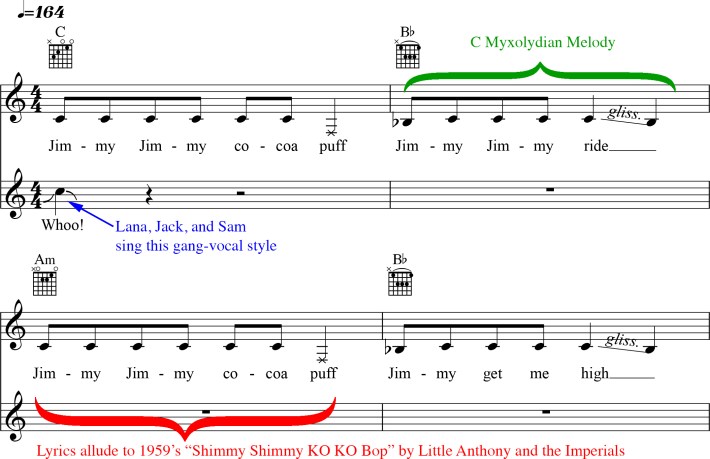
I don’t think I’d ever heard Lana Del Rey rap before, but I believe that’s what she’s doing here. Either that, or she intended it to sound like a schoolyard taunt. Maybe it’s both. (The line, “your mom called, I told her, you’re fucking up big time,” definitely sounds derisive.) This section represents a musical departure for Lana -- and it’s incredibly catchy.
She’s singing (rapping?) a C Mixolydian melody, seemingly riffing on “Shimmy Shimmy KO KO Bop,” the 1959 doo-wop song by Little Anthony And The Imeperials. Notably, the sound of Lana’s voice is uncharacteristically dry here. We usually hear her voice swimming in reverb, as it’s one of the defining characteristics of her vocal sound. She and her producers have a penchant for the Air spring reverb and Valhalla plate reverb, often used together for an extra-soupy effect. (Lana apparently likes to hear that reverb in her headphone monitor mix while tracking as well.) But not here. The dryness of the vocal conveys a sense of immediacy, and the effect is potent.Weirdly, her voice in this closing section exhibits a warbly, processed sound, as though it’s gone through a series of pitch and time manipulations, and the mid-band sonic artifacts have remained. Or maybe that sound is intentional. In any case, when combined with Jack Antonoff’s Mellotron strings, Moog bass line, 808 claps, and those inspired “Whoo!” gang vocals, it produces an incredibly wild ride -- and it’s amazingly infectious.
Over Seven Minutes
Clocking in at 7:14, “A&W” is an ambitious, sprawling single with a musical architecture beautifully sculpted to Lana’s Americana-infused imagery, her breathy crooning, and her candid lyrics. The entire album feels like musical and personal introspection, and it’s well worth a listen, even if you haven’t done a cartwheel since you were nine -- and especially if you’re fucking up big time.
We rely on reader subscriptions to deliver articles like the one you're reading. Become a member and help support independent media!


